alternator RENAULT TWINGO RS 2009 2.G Engine Starting Charging Workshop Manual
[x] Cancel search | Manufacturer: RENAULT, Model Year: 2009, Model line: TWINGO RS, Model: RENAULT TWINGO RS 2009 2.GPages: 22
Page 2 of 22

16A-2
MR-413-X44-16A000$125.mif
V2
16A
STARTING-CHARGING
Fault finding – List and location of components
1Starter motor
2Alternator 3Passenger compartment unit UCH
1
2
New Twingo
3
MR-413-X44-16A000$125.mif
Page 3 of 22
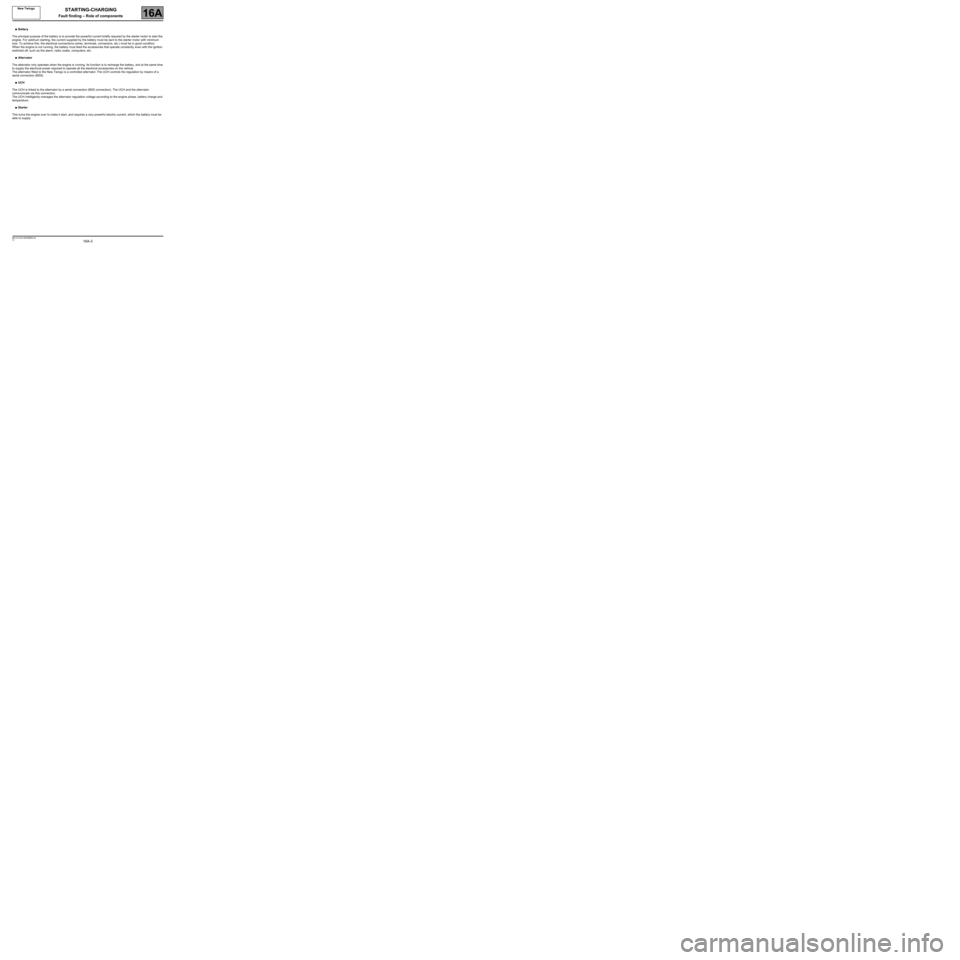
16A-3
MR-413-X44-16A000$250.mif
V2
16A
STARTING-CHARGING
Fault finding – Role of components
●Battery
The principal purpose of the battery is to provide the powerful current briefly required by the starter motor to start the
engine. For optimum starting, the current supplied by the battery must be sent to the starter motor with minimum
loss. To achieve this, the electrical connections (wires, terminals, connectors, etc.) must be in good condition.
When the engine is not running, the battery must feed the accessories that operate constantly, even with the ignition
switched off, such as the alarm, radio codes, computers, etc.
●Alternator
The alternator only operates when the engine is running. Its function is to recharge the battery, and at the same time
to supply the electrical power required to operate all the electrical accessories on the vehicle.
The alternator fitted to the New Twingo is a controlled alternator. The UCH controls the regulation by means of a
serial connection (BSS).
●UCH
The UCH is linked to the alternator by a serial connection (BSS connection). The UCH and the alternator
communicate via this connection.
The UCH intelligently manages the alternator regulation voltage according to the engine phase, battery charge and
temperature.
●Starter
This turns the engine over to make it start, and requires a very powerful electric current, which the battery must be
able to supply.New Twingo
MR-413-X44-16A000$250.mif
Page 4 of 22
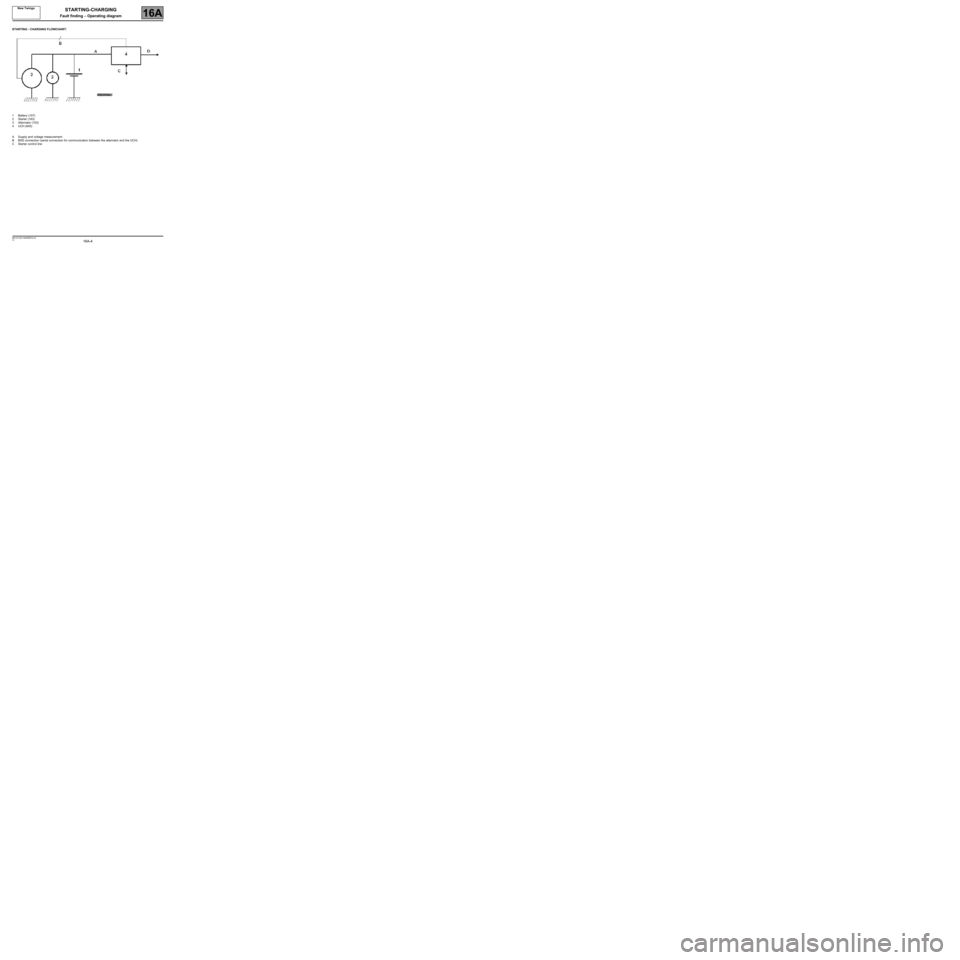
16A-4
MR-413-X44-16A000$375.mif
V2
16A
STARTING-CHARGING
Fault finding – Operating diagram
STARTING - CHARGING FLOWCHART:
1Battery (107)
2Starter (163)
3Alternator (103)
4UCH (645)
ASupply and voltage measurement
BBSS connection (serial connection for communication between the alternator and the UCH)
CStarter control line
New Twingo
MR-413-X44-16A000$375.mif
Page 5 of 22
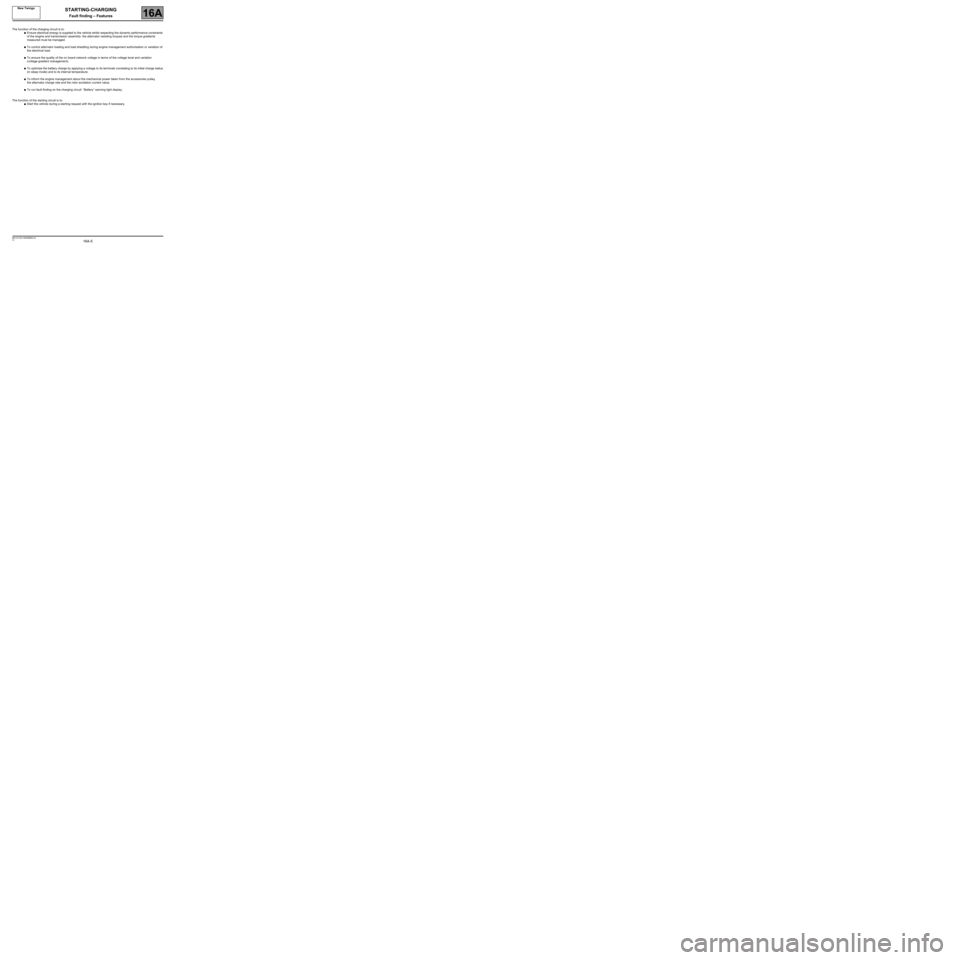
16A-5
MR-413-X44-16A000$500.mif
V2
16A
STARTING-CHARGING
Fault finding – Features
The function of the charging circuit is to:
●Ensure electrical energy is supplied to the vehicle whilst respecting the dynamic performance constraints
of the engine and transmission assembly: the alternator resisting torques and the torque gradients
measured must be managed.
●To control alternator loading and load shedding during engine management authorisation or variation of
the electrical load.
●To ensure the quality of the on board network voltage in terms of the voltage level and variation
(voltage gradient management).
●To optimise the battery charge by applying a voltage to its terminals correlating to its initial charge status
(in sleep mode) and to its internal temperature.
●To inform the engine management about the mechanical power taken from the accessories pulley,
the alternator charge rate and the rotor excitation current value.
●To run fault finding on the charging circuit: “Battery” warning light display.
The function of the starting circuit is to:
●Start the vehicle during a starting request with the ignition key if necessary. New Twingo
MR-413-X44-16A000$500.mif
Page 16 of 22
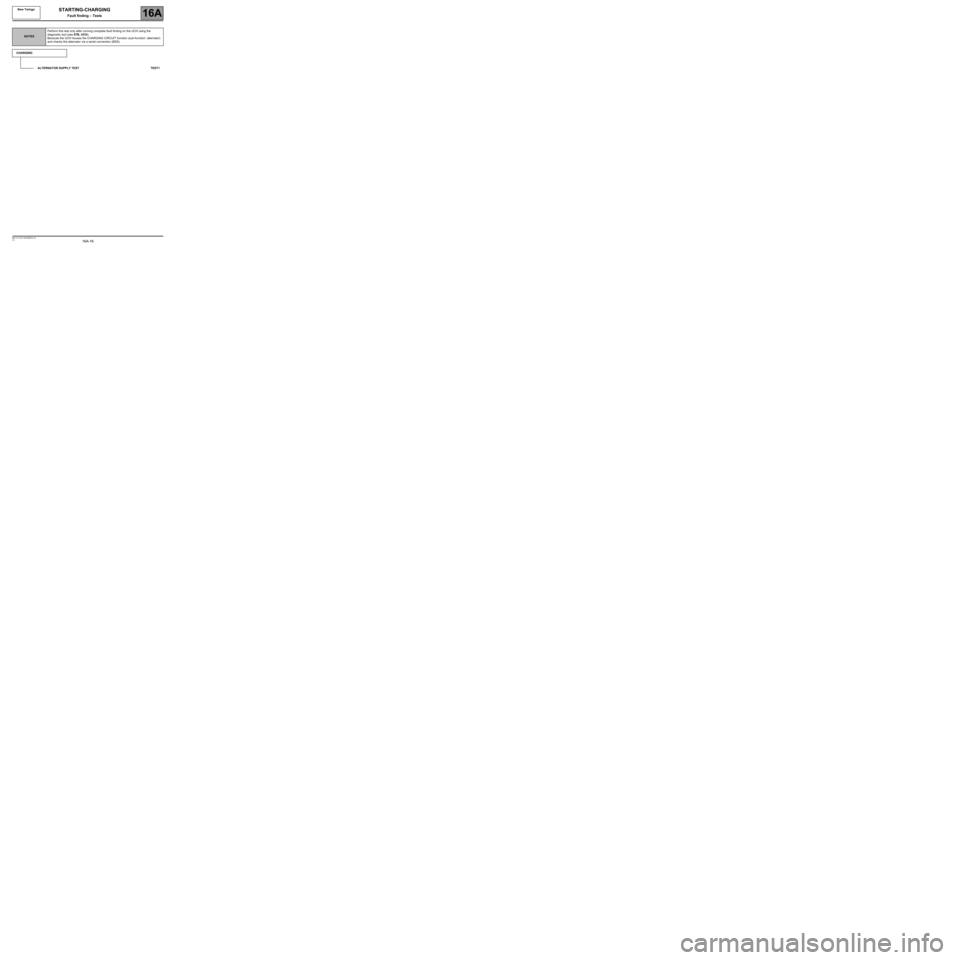
16A-16V2 MR-413-X44-16A000$875.mif
16A
New Twingo
NOTESPerform this test only after running complete fault finding on the UCH using the
diagnostic tool (see 87B, UCH).
Because the UCH houses the CHARGING CIRCUIT function (sub-function: alternator)
and checks the alternator via a serial connection (BSS).
CHARGING
ALTERNATOR SUPPLY TEST TEST1
STARTING-CHARGING
Fault finding – Tests
Page 17 of 22

16A-17V2 MR-413-X44-16A000$875.mif
STARTING-CHARGING
Fault finding – Tests16A
New Twingo
TEST1 Alternator supply test
NOTESTest the condition of the battery (see 80A, Battery).
Measure the voltage at the battery terminals with the engine warm and running at idle speed for 2 minutes and with
all consumers switched off.
Voltage value?
Replace the alternator (see MR 411, 16A, Starting - Charging,
Alternator: Removal - Refitting).
Visually inspect the consequences (battery condition, corrosion, etc.).
With the engine at idle speed, connect a current clamp to the alternator B+ wire, connection BPDA, with all
consumers switched off.
Current < 5 ACurrent between 5 A
and 35 ACurrent > 35A
Replace the alternator
(see MR 411, 16A, Starting -
Charging, Alternator:
Removal - Refitting).Keep the engine speed at
3000 rpm and still with no
consumers switched on.Check that there are no
electrical components
consuming an abnormal
amount of current.
Disconnect the fuses one by
one to identify the consumer.
To be examined Value of measured current?
(i 1)
< 14.8V> 14.8V
A
Page 18 of 22
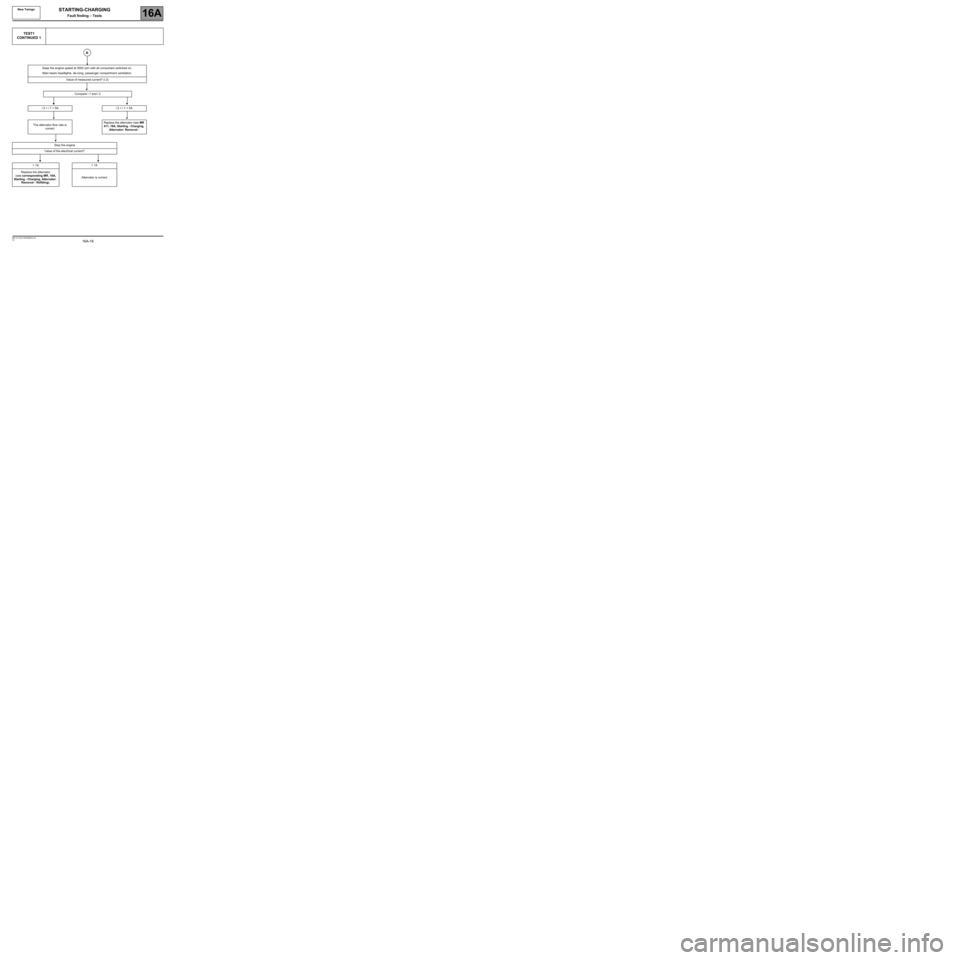
16A-18V2 MR-413-X44-16A000$875.mif
STARTING-CHARGING
Fault finding – Tests16A
New Twingo
TEST1
CONTINUED 1
Keep the engine speed at 3000 rpm with all consumers switched on.
Main beam headlights, de-icing, passenger compartment ventilation.
Value of measured current? (i 2)
Compare i 1 and i 2
i 2 > i 1 + 5A i 2 < i 1 + 5A
The alternator flow rate is
correctReplace the alternator (see MR
411, 16A, Starting - Charging,
Alternator: Removal -
Stop the engine
Value of the electrical current?
> 1A < 1A
Replace the alternator
(see corresponding MR, 16A,
Starting - Charging, Alternator:
Removal - Refitting).Alternator is correct
A
Page 19 of 22
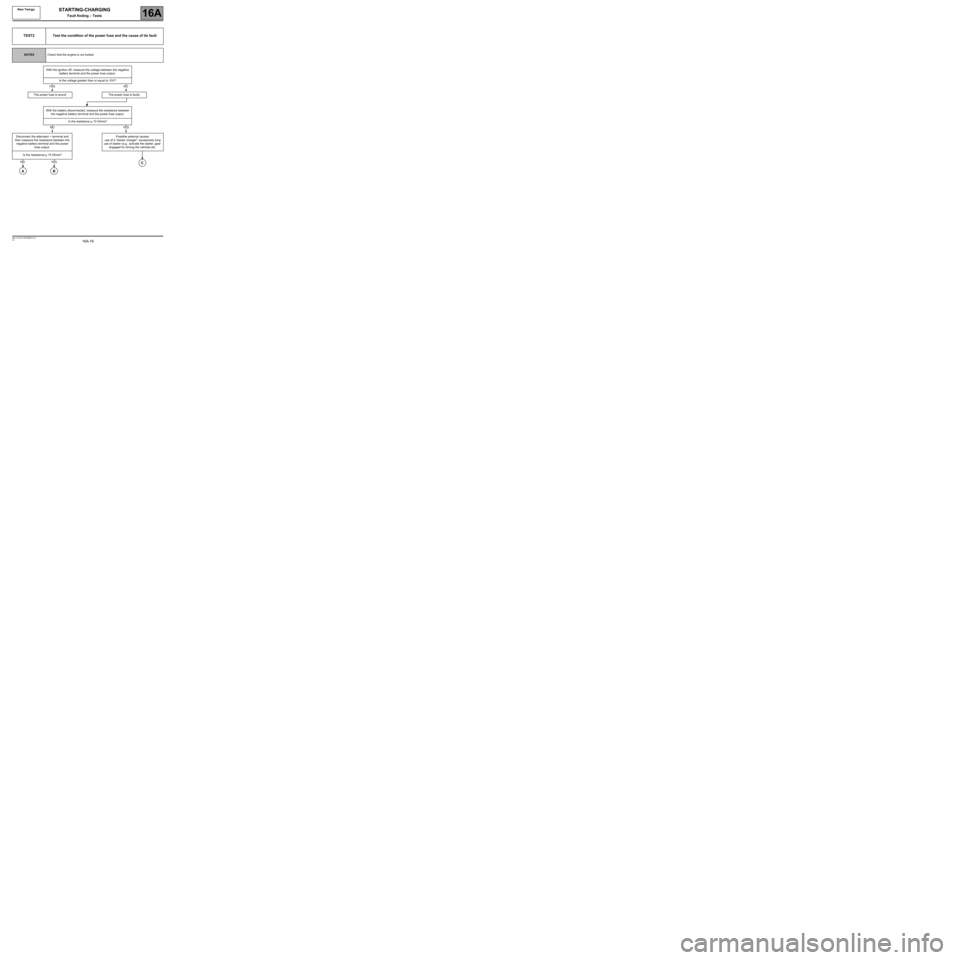
16A-19V2 MR-413-X44-16A000$875.mif
STARTING-CHARGING
Fault finding – Tests16A
New Twingo
TEST2 Test the condition of the power fuse and the cause of its fault
NOTESCheck that the engine is not locked
With the ignition off, measure the voltage between the negative
battery terminal and the power fuse output.
Is the voltage greater than or equal to 10V?
The power fuse is sound The power fuse is faulty
With the battery disconnected, measure the resistance between
the negative battery terminal and the power fuse output.
Is the resistance
≥ 10 Ohms?
Disconnect the alternator + terminal and
then measure the resistance between the
negative battery terminal and the power
fuse output.Possible external causes:
use of a "starter charger", excessively long
use of starter (e.g.: activate the starter, gear
engaged for driving the vehicle) etc.
Is the resistance
≥ 10 Ohms?
YESNO
NOYES
CNO
A
YES
B
Page 20 of 22
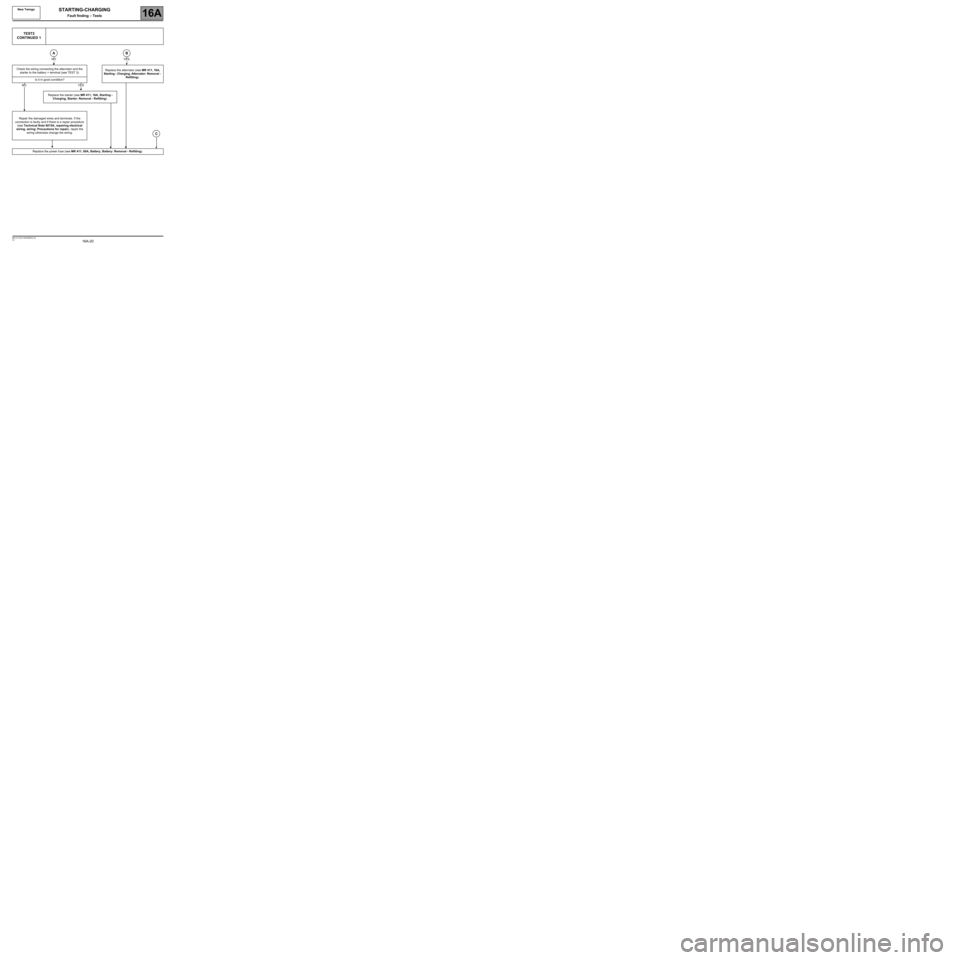
16A-20V2 MR-413-X44-16A000$875.mif
STARTING-CHARGING
Fault finding – Tests16A
New Twingo
TEST2
CONTINUED 1
Check the wiring connecting the alternator and the
starter to the battery + terminal (see TEST 3).Replace the alternator (see MR 411, 16A,
Starting - Charging, Alternator: Removal -
Refitting).
Is it in good condition?
Replace the starter (see MR 411, 16A, Starting -
Charging, Starter: Removal - Refitting).
Repair the damaged wires and terminals. If the
connection is faulty and if there is a repair procedure
(see Technical Note 6015A, repairing electrical
wiring, wiring: Precautions for repair), repair the
wiring otherwise change the wiring.
Replace the power fuse (see MR 411, 80A, Battery, Battery: Removal - Refitting).
A
NO
B
YES
NOYES
C
Page 22 of 22
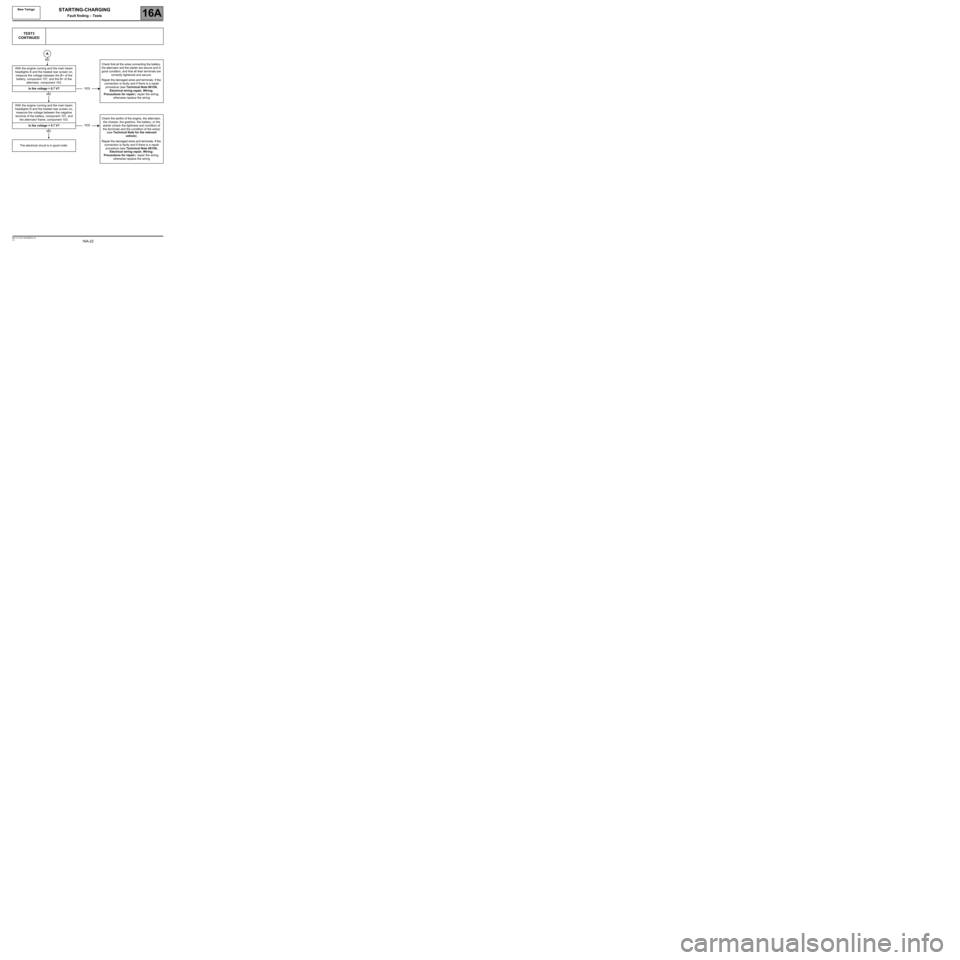
16A-22V2 MR-413-X44-16A000$875.mif
STARTING-CHARGING
Fault finding – Tests16A
New Twingo
TEST3
CONTINUED
Check that all the wires connecting the battery,
the alternator and the starter are secure and in
good condition, and that all their terminals are
correctly tightened and secure.
Repair the damaged wires and terminals. If the
connection is faulty and if there is a repair
procedure (see Technical Note 6015A,
Electrical wiring repair, Wiring:
Precautions for repair), repair the wiring,
otherwise replace the wiring With the engine running and the main beam
headlights lit and the heated rear screen on,
measure the voltage between the B+ of the
battery, component 107, and the B+ of the
alternator, component 103.
Is the voltage > 0.7 V?
With the engine running and the main beam
headlights lit and the heated rear screen on,
measure the voltage between the negative
terminal of the battery, component 107, and
the alternator frame, component 103.Check the earths of the engine, the alternator,
the chassis, the gearbox, the battery, or the
starter (check the tightness and condition of
the terminals and the condition of the wires)
(see Technical Note for the relevant
vehicle).
Repair the damaged wires and terminals. If the
connection is faulty and if there is a repair
procedure (see Technical Note 6015A,
Electrical wiring repair, Wiring:
Precautions for repair), repair the wiring,
otherwise replace the wiring Is the voltage > 0.7 V?
The electrical circuit is in good order.
A
NO
YES
NO
YES
NO